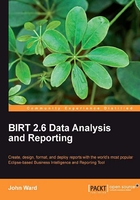
Where do I get BIRT?
Our first task should be to download BIRT. The typical location for everything BIRT related is the Eclipse website. Browsing to

The homepage is also where one can get the various BIRT distributions such as the All-In-One Eclipse package. This distribution contains a prepackaged version of Eclipse, which is configured with BIRT, the BIRT Standalone Report Designer, and contains information about retrieving and building BIRT from source.
At the time of this writing, 2.6 is the latest BIRT release, which is what we will be referring to throughout this book. The same steps will work with all previous versions of BIRT, unless otherwise noted
There are several installation paths to choose from. The one I highly recommend is the BIRT All-in-One package. One can also install BIRT as a plugin to go into an already existing Eclipse installation or one can retrieve the BIRT Standalone RCP package. The chapter will give detailed information about each one of these packages along with the benefits of, and the reasons to use each method.
In addition to the BIRT homepage, we can also retrieve BIRT from the BIRT Exchange. The BIRT Exchange is an Actuate sponsored website that contains information on all things, including open source BIRT, commercial BIRT, and BIRT-based products. The BIRT Exchange also has a helpful community section with message boards where users can ask questions regarding BIRT, post and download examples, and participate in contests for the most useful submissions of the month. It is located at
